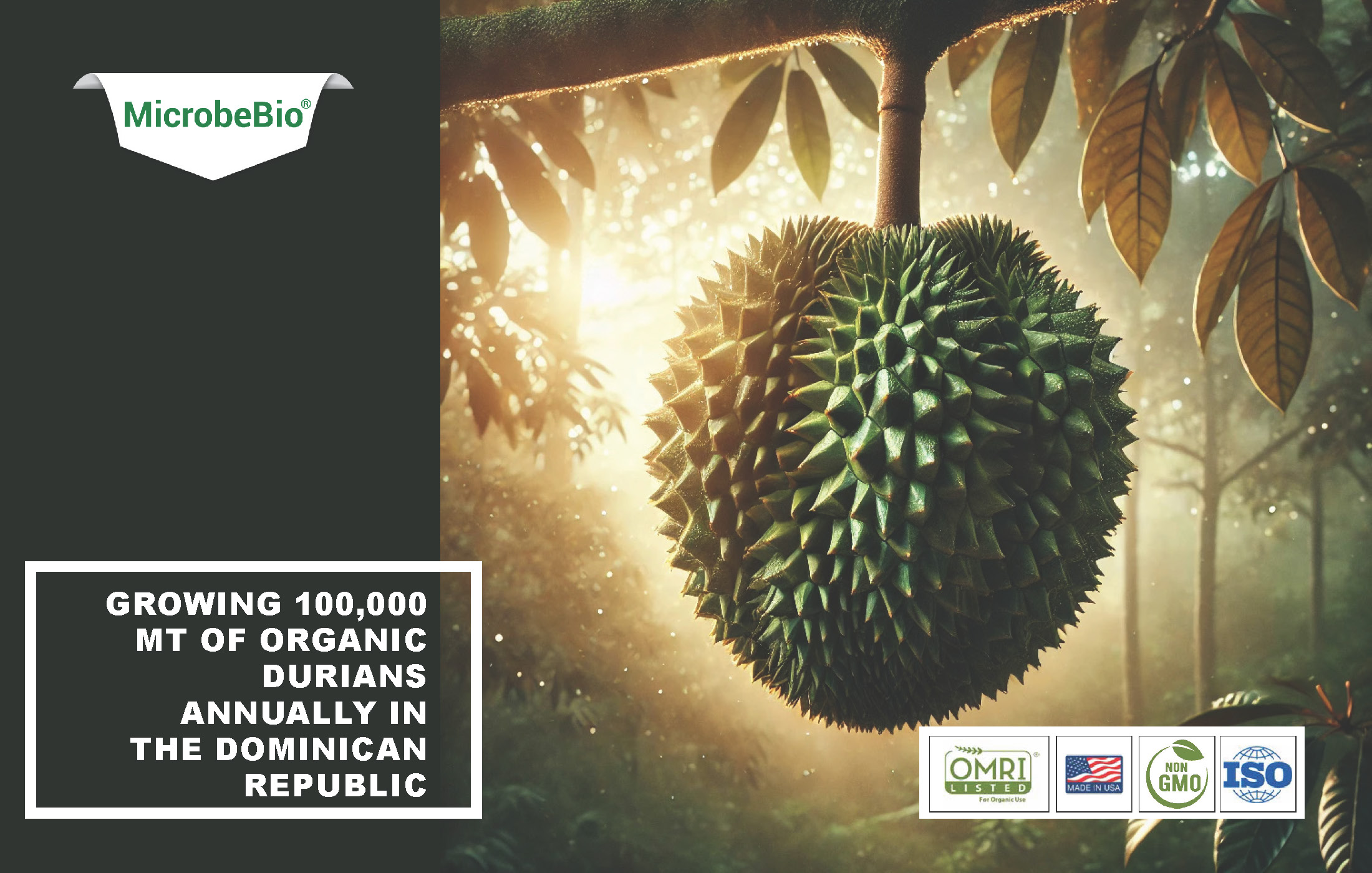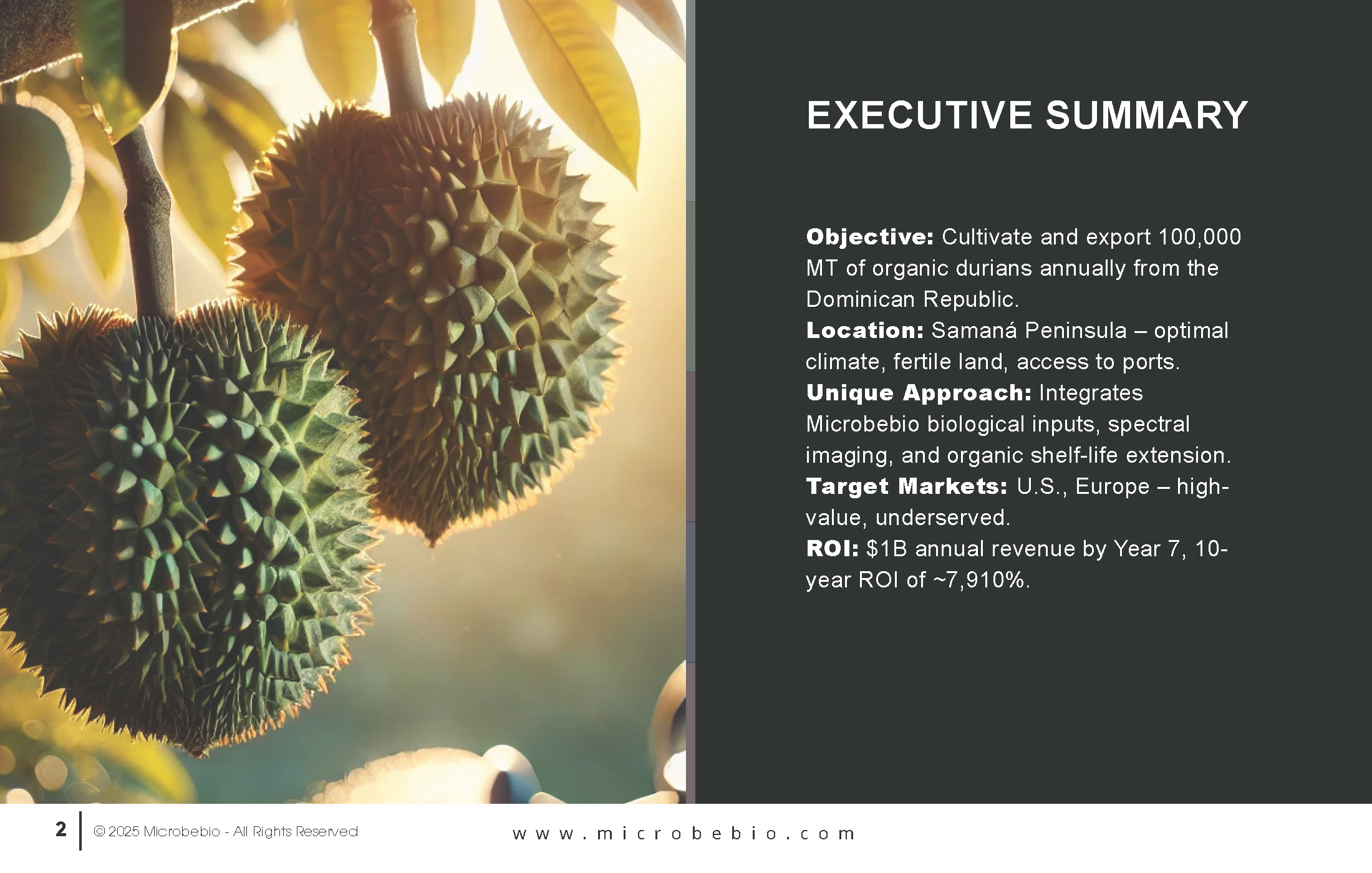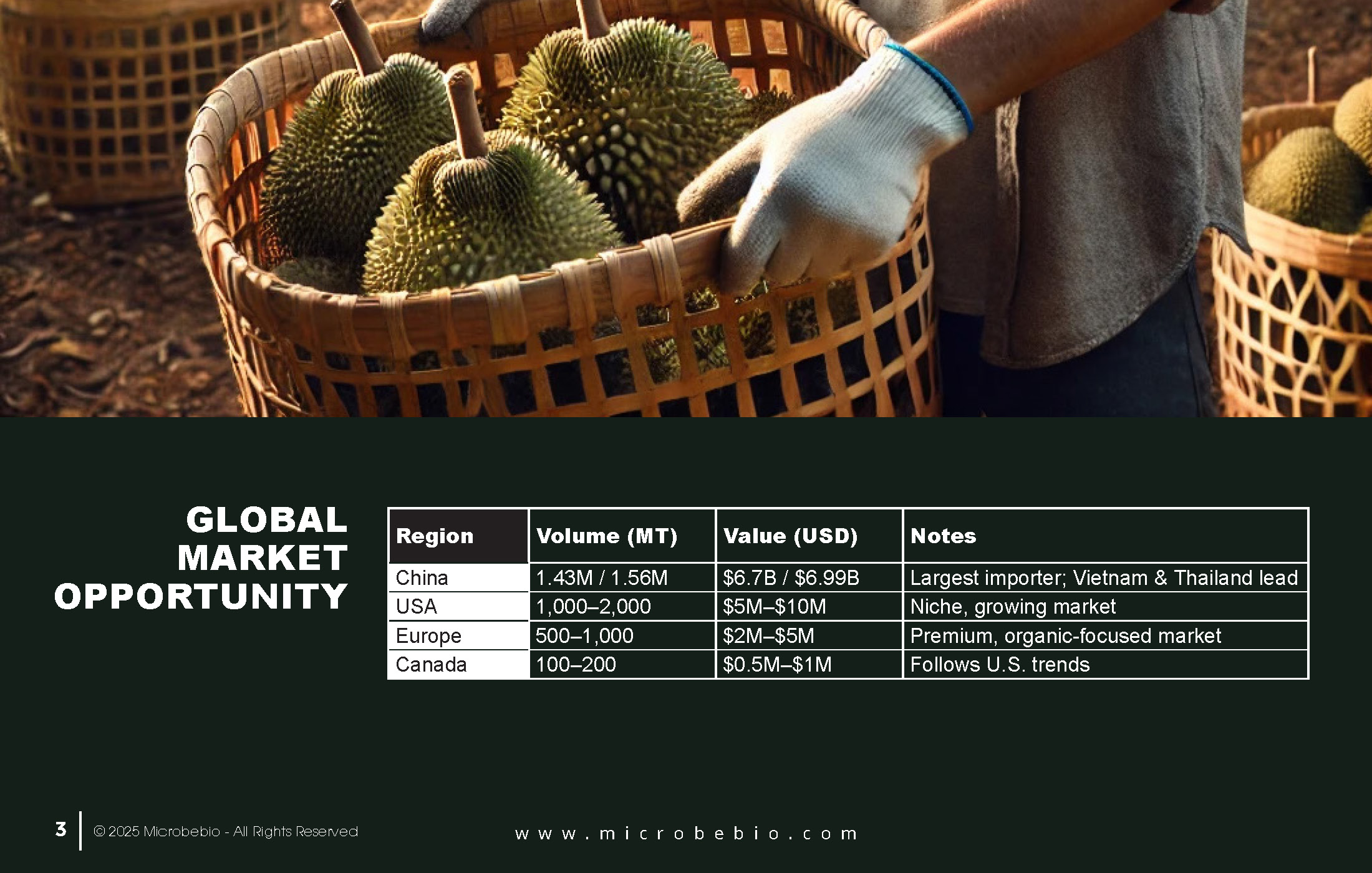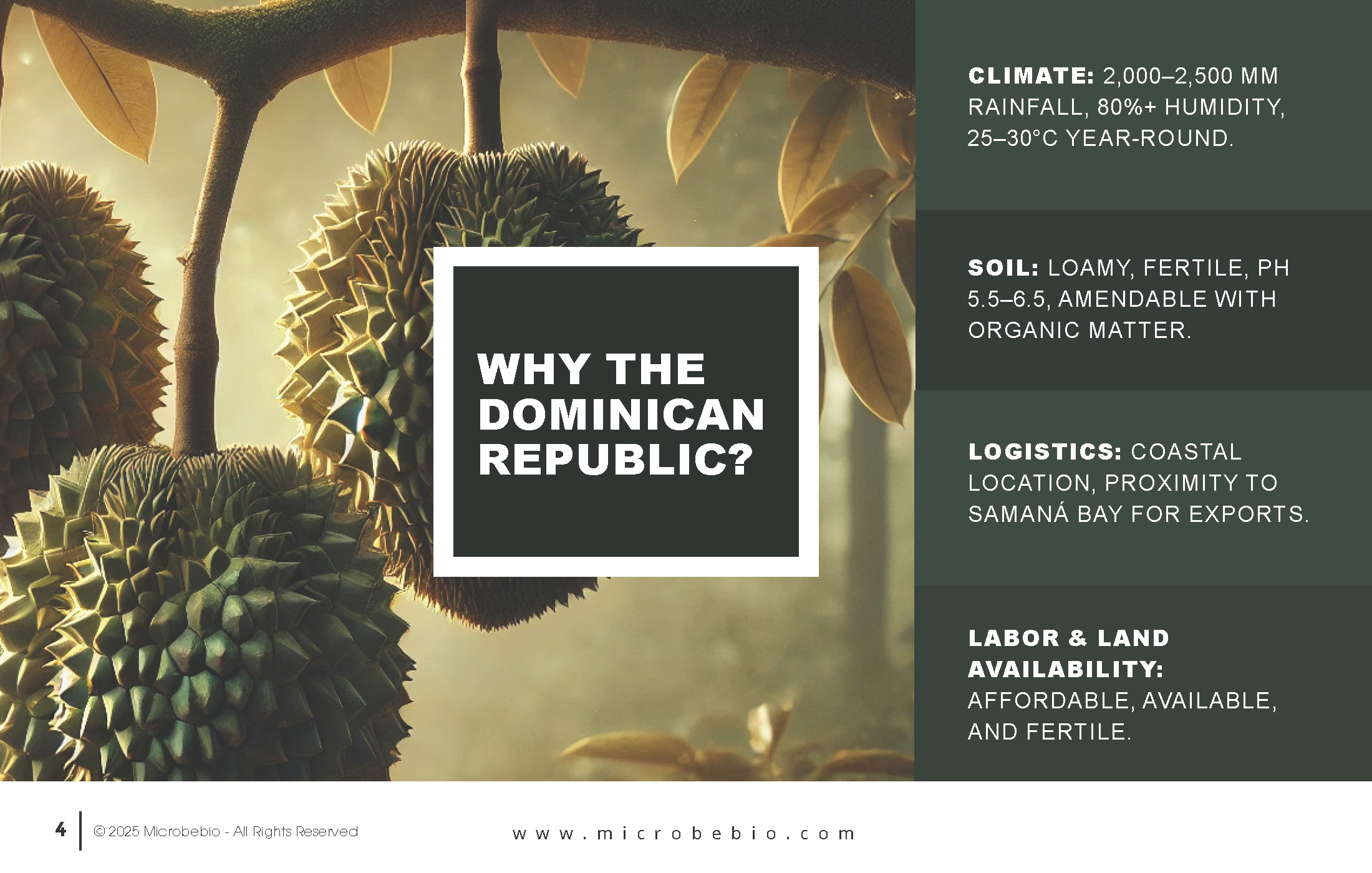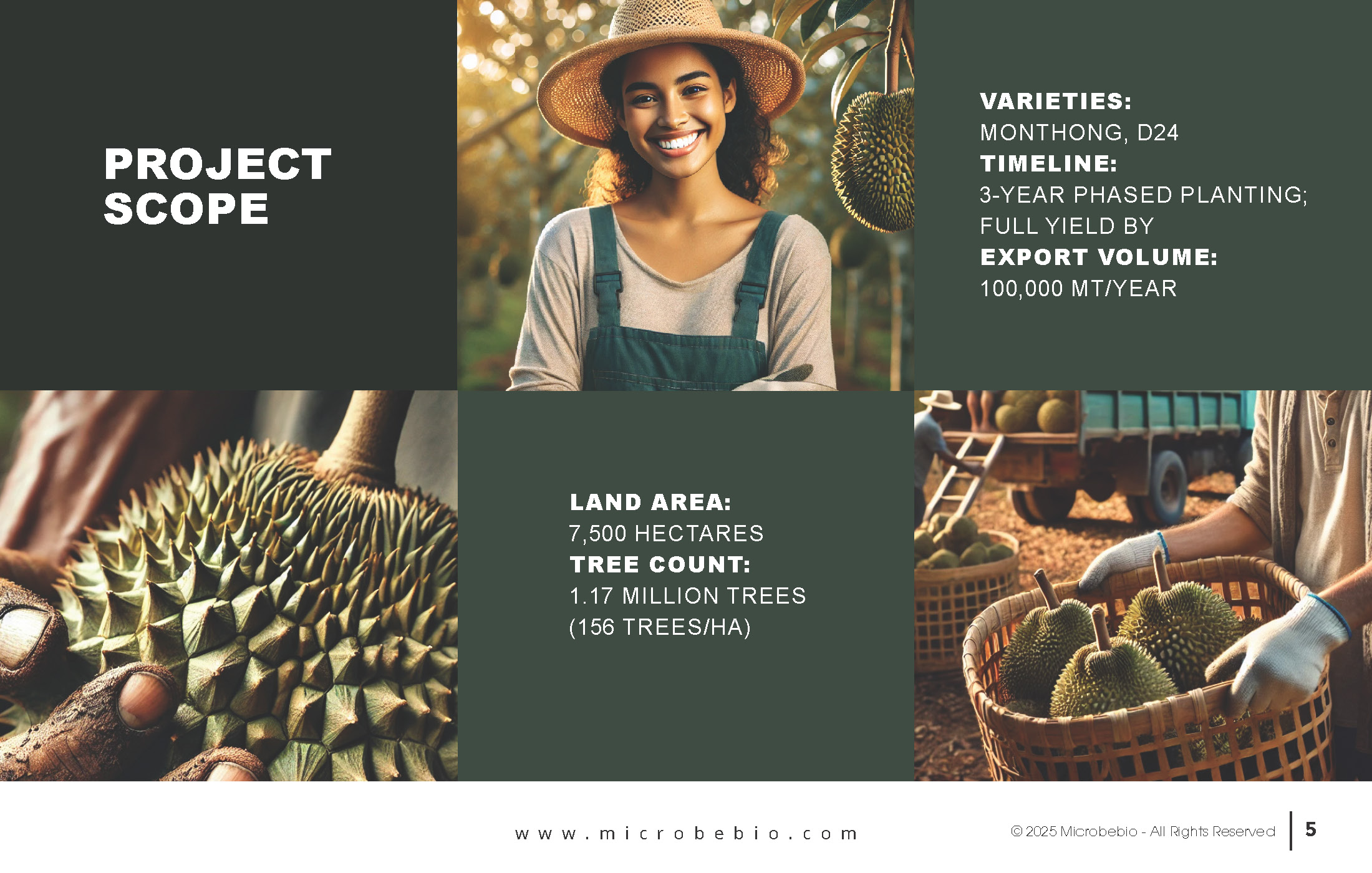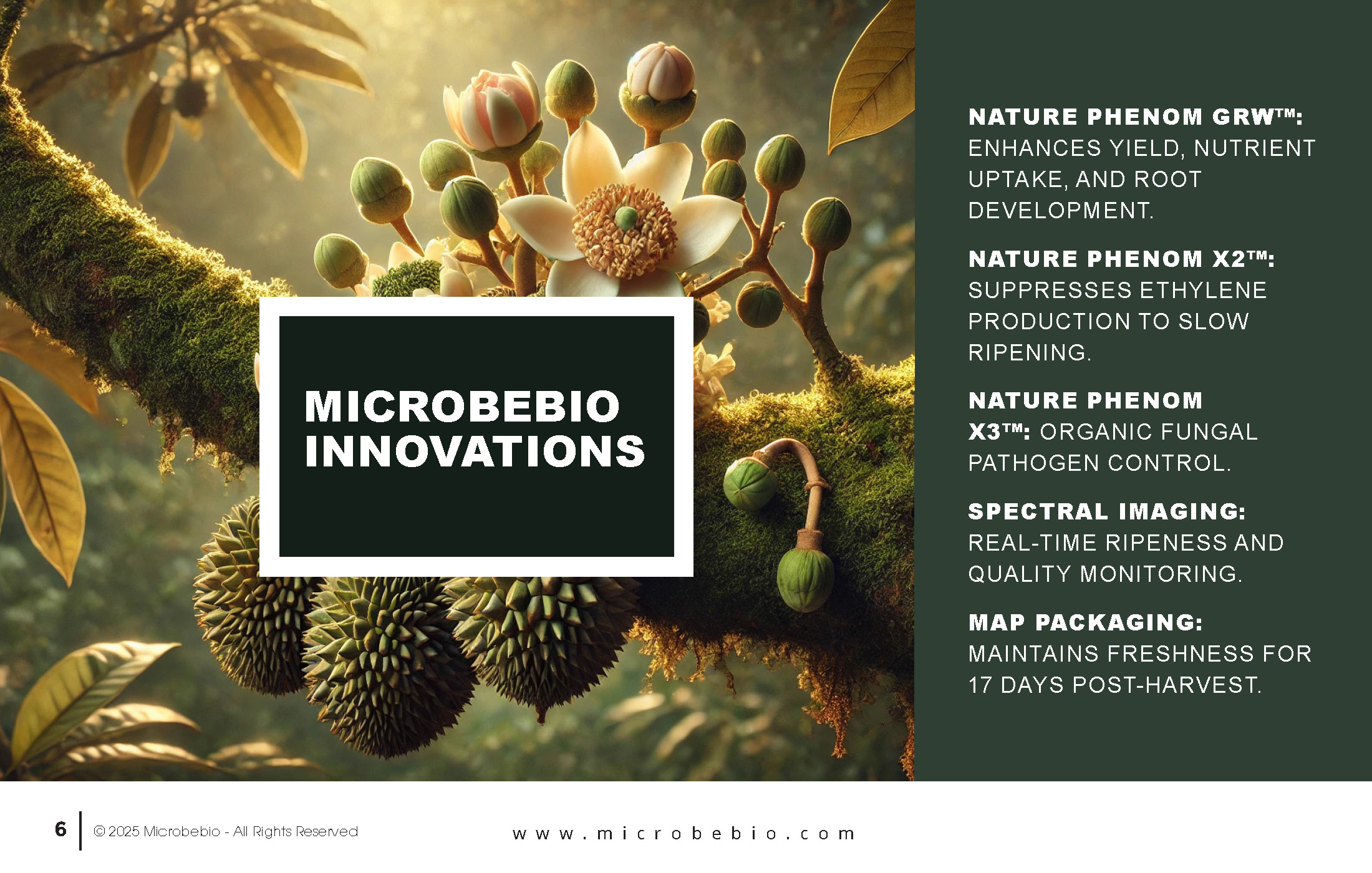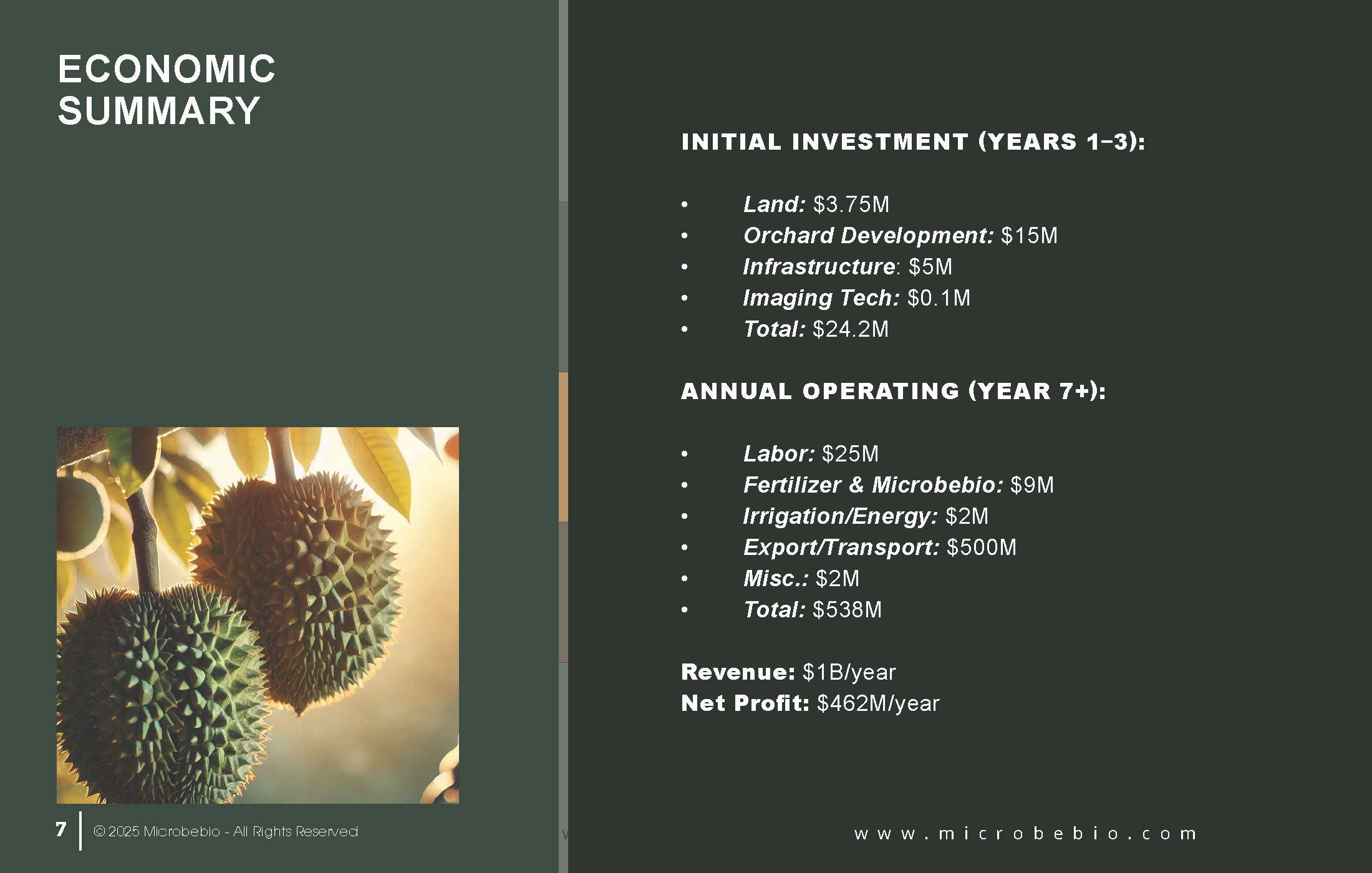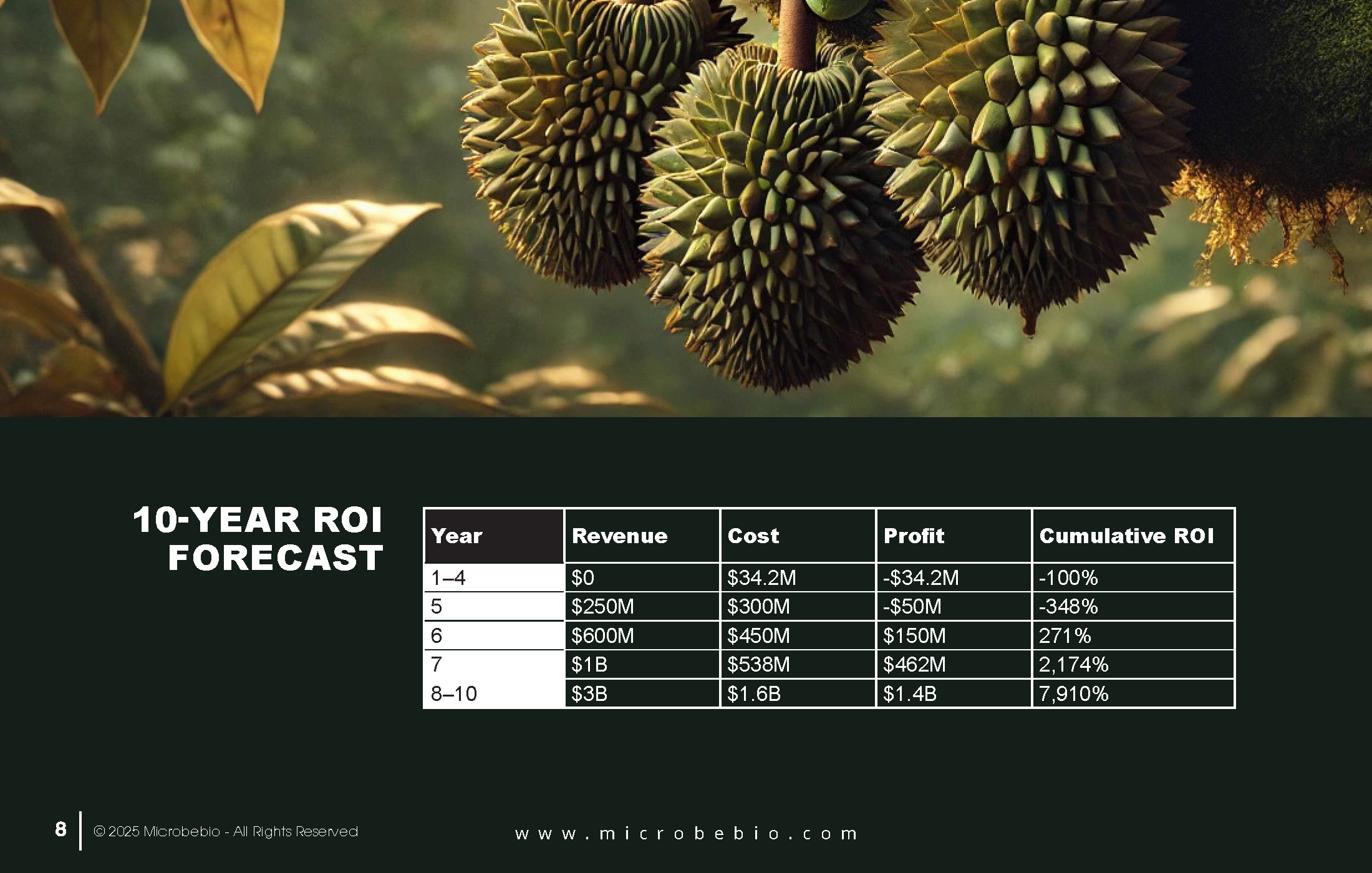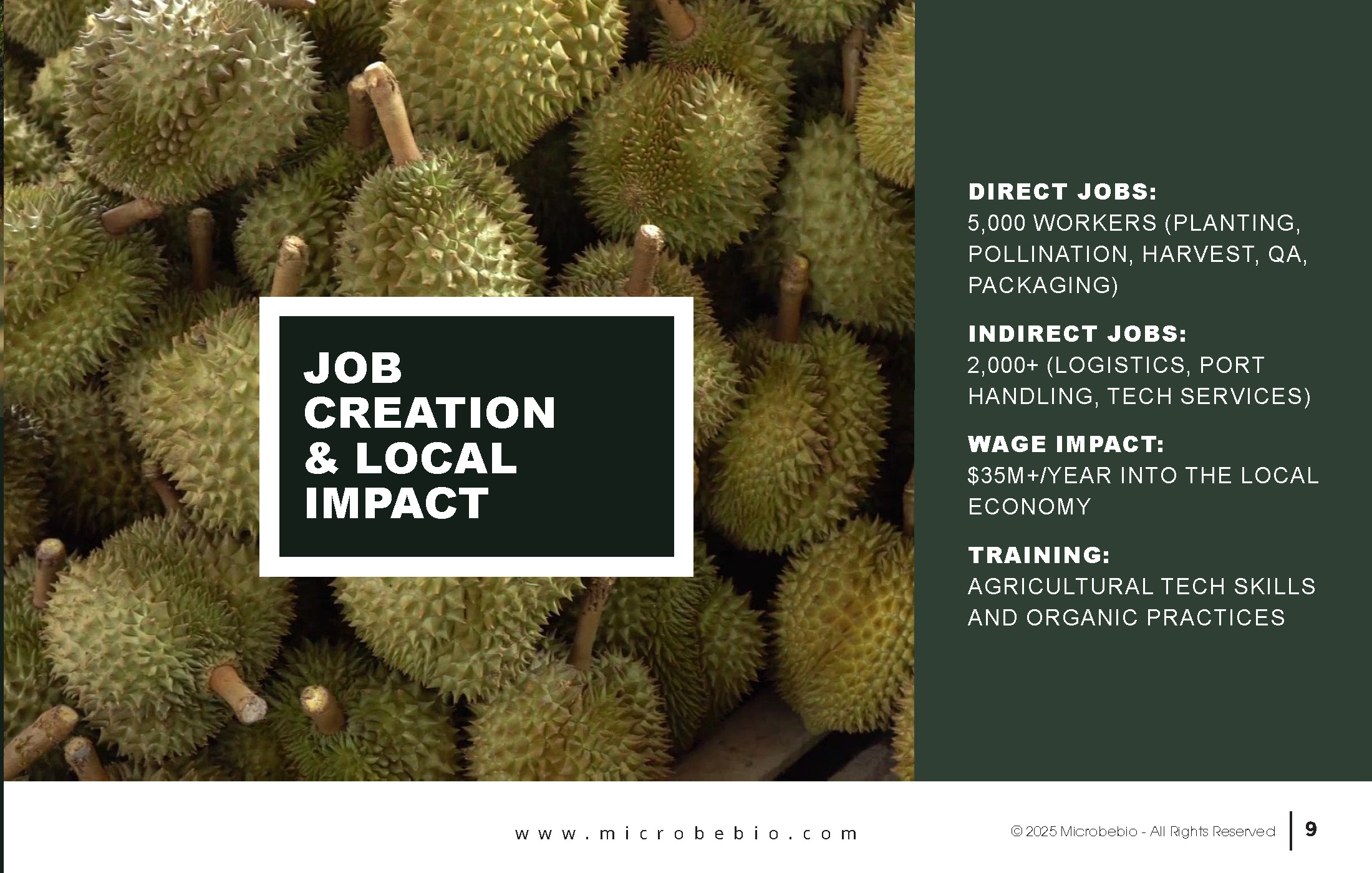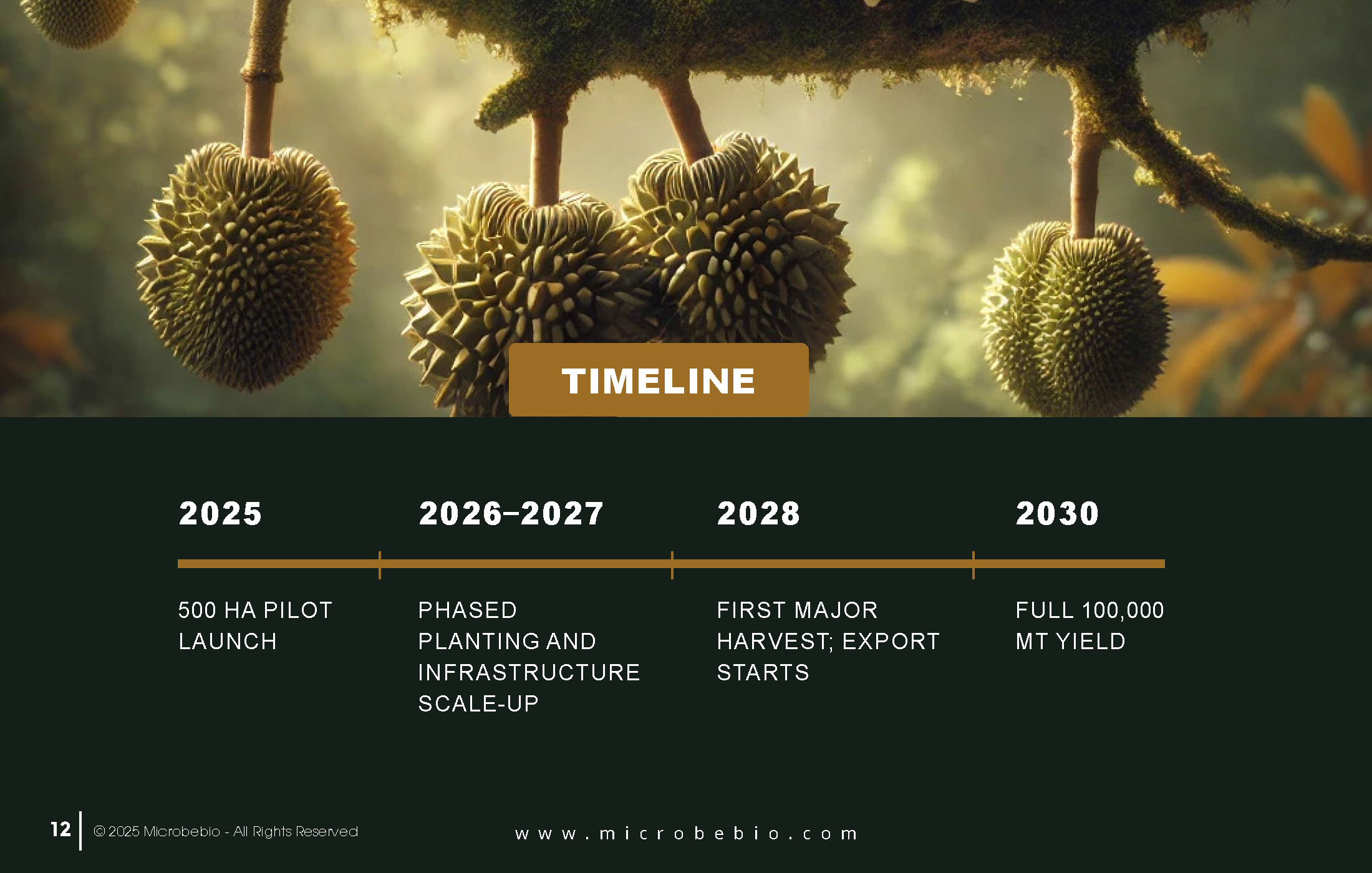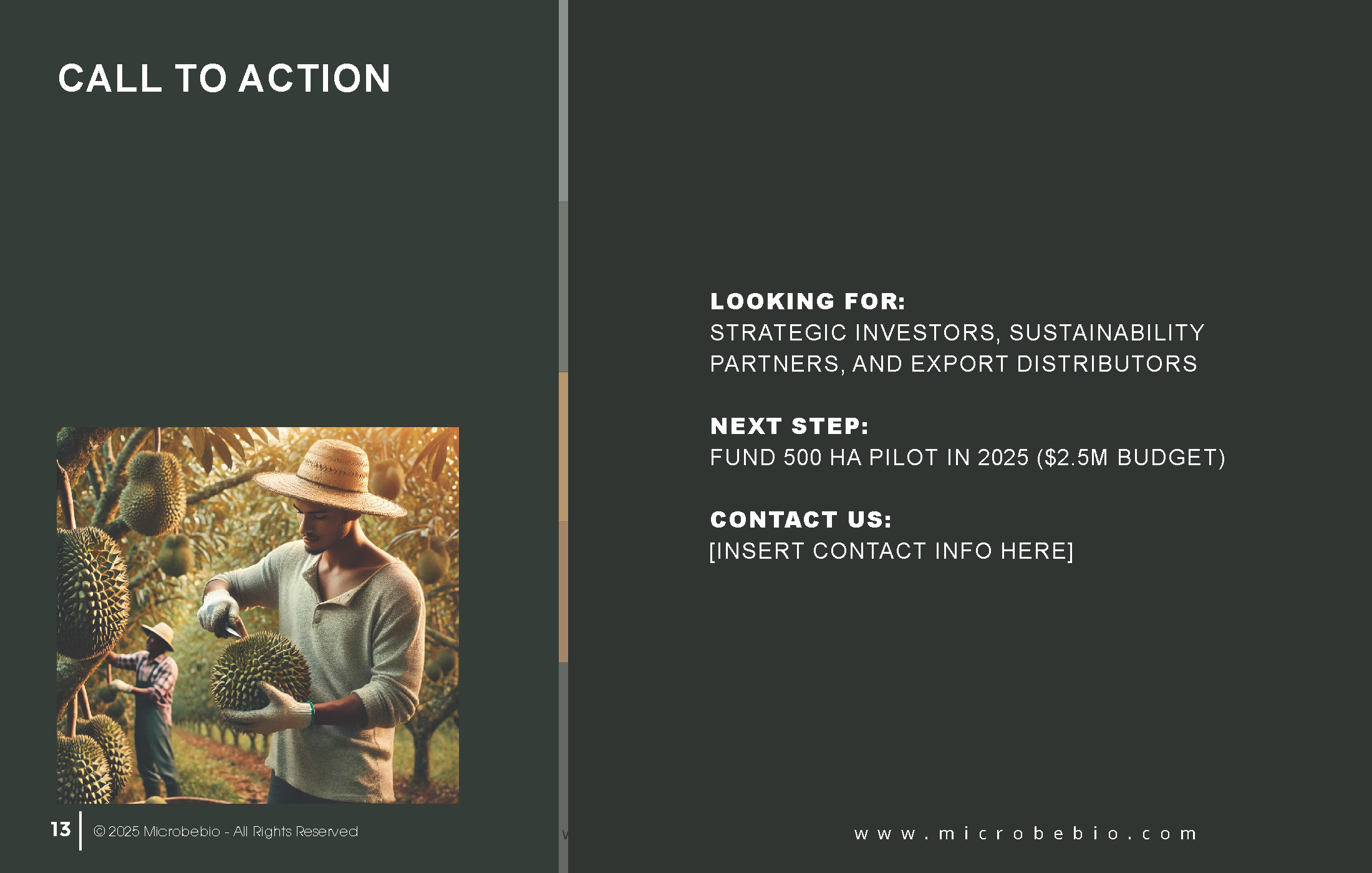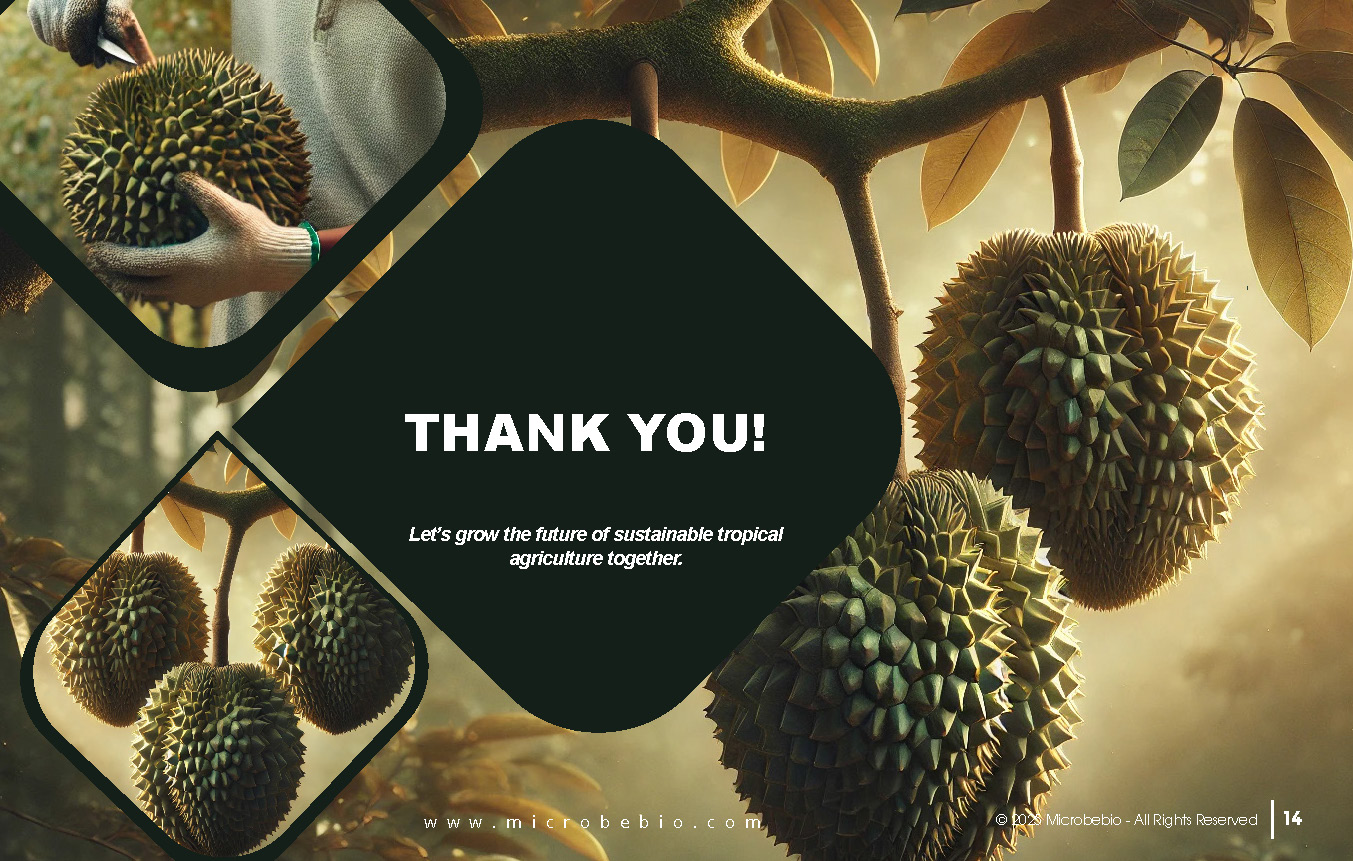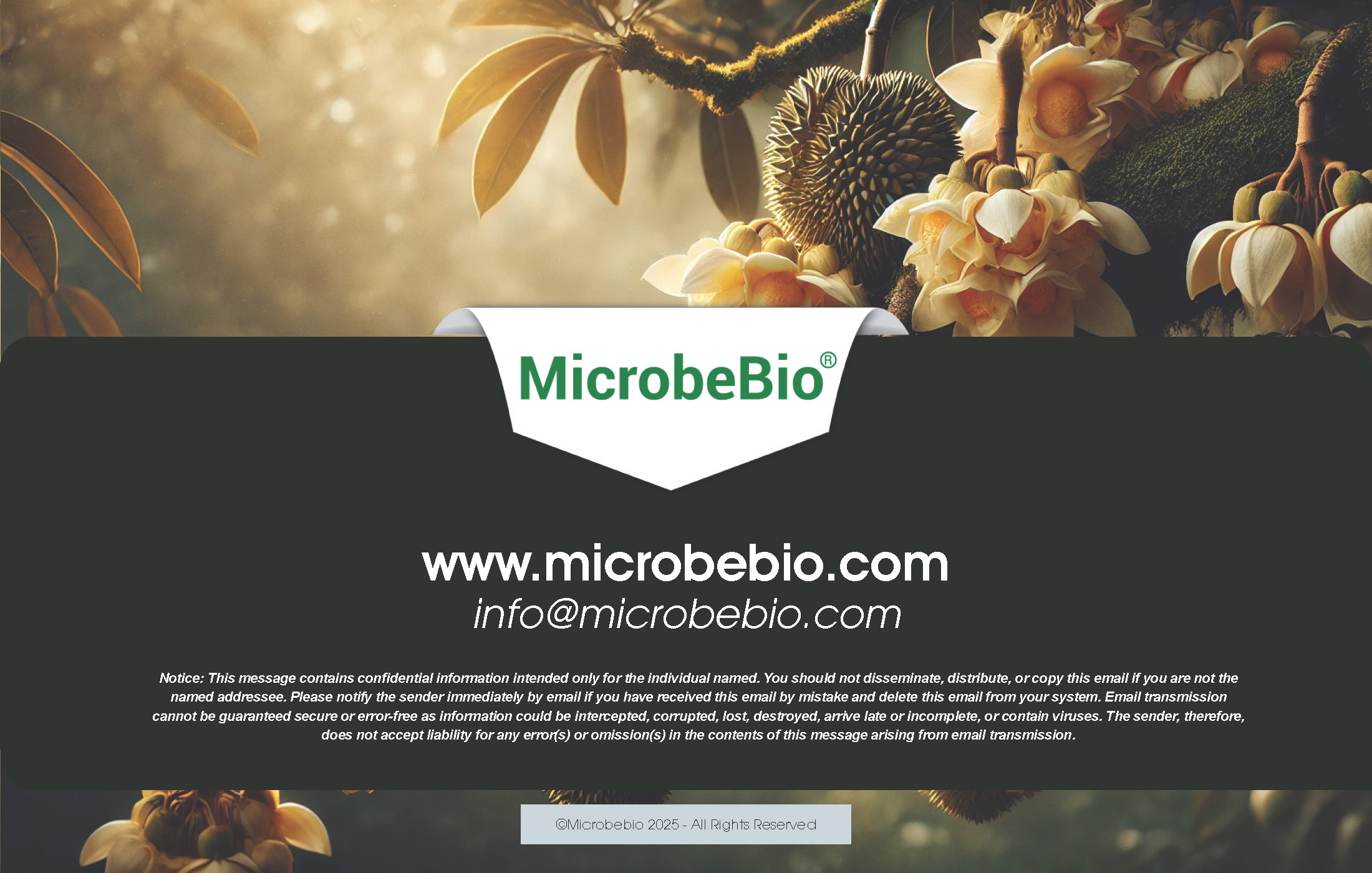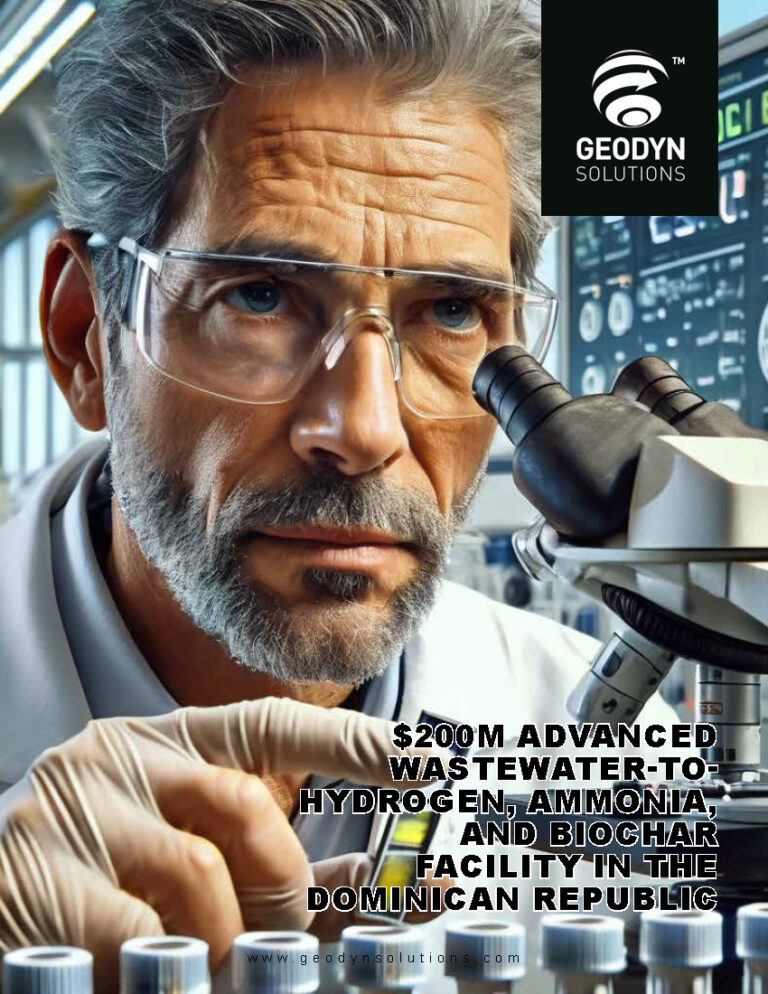Proposal for Microbebio: Growing 50,000 MT of Durians Annually in the Dominican Republic
Executive Summary
Microbebio proposes a strategic project to cultivate 50,000 MT of durians annually in the Dominican Republic, targeting the Samaná Peninsula for its tropical climate (2,000–2,500 mm rainfall, 80%+ humidity, 25–30°C), which mirrors durian’s native Southeast Asian conditions. This initiative leverages Spectral Imaging Technology for non-destructive quality assessment and an enhanced organic shelf-life extension solution to achieve 30 days of post-harvest viability. By managing ethylene production and fungal growth organically, we aim to produce high-quality durians for export, primarily to the U.S. and Europe, while creating jobs, ensuring sustainability, and delivering a strong return on investment (ROI).
Project Objectives
- Produce 50,000 MT of organic durians annually in the Dominican Republic.
- Implement Spectral Imaging Technology for real-time quality assessment of durian ripeness and health.
- Develop an economical organic solution to extend shelf life to 30 days, preserving quality for export.
- Establish a sustainable operation on the Samaná Peninsula, creating jobs and boosting the local economy.
- Achieve a positive ROI within 5–7 years, targeting export markets in the U.S. and Europe.
Location: Samaná Peninsula
Rationale: The Samaná Peninsula offers a tropical climate ideal for durian:
- Rainfall: 2,000–2,500 mm annually, sufficient with irrigation to meet durian’s 1,500–4,000 mm requirement.
- Humidity: 80%+, aligning with durian’s 70–90% preference.
- Temperature: 25–30°C year-round, matching durian’s 24–30°C optimal range.
- Altitude: Coastal plains below 800 meters, ideal for durian growth.
- Soil: Fertile loamy soils can be amended with organic matter to meet durian’s needs (pH 5.5–6.5, well-drained).
Advantages: Proximity to ports (e.g., Samaná Bay) facilitates export logistics to the U.S. (1,000–2,000 MT domestic demand) and Europe (500–1,000 MT).
Land Requirements
- Yield Benchmark: In Southeast Asia, mature durian orchards yield 10–20 MT per hectare annually (e.g., Thailand’s Monthong variety averages 15 MT/ha).
- Target: 50,000 MT requires 2,500–5,000 hectares, assuming a conservative 10–15 MT/ha yield with organic methods and Microbebio’s microbial enhancements.
- Proposed Area: 3,750 hectares (mid-range estimate) to account for initial lower yields (5–10 MT/ha in years 1–5) and scaling to 13–15 MT/ha by year 7 with optimized practices.
- Land Use: Samaná Peninsula has available agricultural land, supplemented by reclaimed or leased plots, avoiding deforestation to maintain organic certification.
Production Plan
- Cultivar Selection: Use hardy, high-yield varieties like “Monthong” (Thailand) and “D24” (Malaysia), adaptable to slight climatic variations.
- Planting:
– Spacing: 8×8 meters (156 trees/ha).
– Trees: 585,000 trees across 3,750 ha.
– Timeline: Planting in phases (1,250 ha/year over 3 years), with fruiting starting in year 5. - Microbebio Microbial Enhancement:
– Apply Microbebio Nature Phenom GRW™ to boost soil health, yield, flavor, and pest resistance.
– Use Nature Phenom X3™ (200 g/ha for prevention, 500 g/ha for treatment) to control soil-borne fungi (e.g., Phytophthora). - Irrigation: Install drip irrigation to supplement rainfall during the dry season (Dec–April), ensuring 1,500–2,000 mm total water annually.
- Pollination: Employ manual pollination (due to lack of native bat pollinators) and introduce beehives to enhance natural pollination.
Spectral Imaging Technology for Quality Assessment
- Technology: Deploy transmittance spectroscopy (e.g., 780–860 nm range) to assess ripeness non-destructively, as validated by studies showing correlations of 0.711–0.763 with ripeness levels.
- Implementation: Equip orchards with portable spectral imaging devices linked to a central database, enabling real-time monitoring of fruit maturity and quality.
- Benefits: Ensures only ripe, high-quality durians are harvested, reducing waste and optimizing export value (e.g., Grade A durians fetch $10–$20/kg vs. $4–$6/kg for average quality).
Organic Shelf-Life Extension Solution (30 Days)
Goal: Extend shelf life to 30 days post-harvest for export, managing ethylene and fungal growth organically.
Methods:
Ethylene Management:
Use Microbebio’s probiotic formula (e.g., Nature Phenom X2™) to suppress ethylene production post-harvest, applied as a fruit coating or soil treatment pre-harvest.
Store in modified atmosphere packaging (MAP) with 3–5% O₂ and 5–15% CO₂, reducing respiration and ethylene rates (extends life to 8 weeks at 14°C, per postharvest studies; adjusted to 30 days with enhanced organic treatments).
Fungal Control:
Apply Microbebio Nature Phenom X3™ post-harvest (spray or dip) to combat Phytophthora and other fungi, leveraging its natural antifungal properties.
Use organic essential oil coatings (e.g., lemongrass or clove oil) to inhibit mold growth.
Packaging:
PET/PE micro-perforated films (optimal for Monthong durian, per research) to balance moisture and gas exchange, minimizing weight loss (0.58–3.07%) and microbial growth.
Store at 14–16°C during transport to slow ripening while avoiding chilling injury, with enhanced organic coatings to extend viability beyond standard limits.
Outcome: Maintains firmness, aroma, and nutritional quality for 30 days, exceeding U.S./Europe export windows (7–10 days shipping + extended market shelf time).
Economic Analysis
1. Initial Investment:
- Land Acquisition/Leasing: $500/ha x 3,750 ha = $1.875M.
- Planting (trees, labor, irrigation): $2,000/ha x 3,750 ha = $7.5M.
- Spectral Imaging Tech: $1,000/unit x 25 units = $25,000 (plus $25,000 annual maintenance).
- Fertilizer: $600/ha/year x 3,750 ha = $2.25M/year.
Infrastructure (storage, packaging, transport): $2.5M. - Total Initial Cost: ~$14.15M over 3 years (excludes first-year fertilizer, included in operating costs).
2. Annual Operating Costs (Full Production, Year 7+):
- Labor: 2,500 workers x $5,000/year avg. salary = $12.5M.
- Fertilizer: $600/ha/year x 3,750 ha = $2.25M.
- Irrigation/Energy: $1M.
Packaging/Transport: $5/kg x 50,000 MT = $250M (conservative; includes export logistics). - Maintenance/Misc.: $1M.
Total: ~$266.75M/year.
3. Revenue:
- Export Price: $10/kg (Grade A organic durian, conservative vs. $15–$20/kg for premium varieties like Musang King).
50,000 MT x $10,000/MT = $500M/year.
- Export Price: $10/kg (Grade A organic durian, conservative vs. $15–$20/kg for premium varieties like Musang King).
4. ROI:
- Gross Profit: $500M – $266.75M = $233.25M/year.
- Breakeven: $14.15M investment recovered in ~1 month of full production (year 7).
- Annual ROI (Year 7+): ($233.25M / $14.15M) x 100 = ~1,648% (assuming reinvestment stabilizes costs).
Job Creation
Direct Jobs:
- 2,500 workers (farm labor, pollination, harvest, packaging) at $5,000/year average salary.
Indirect Jobs:
- 1,000+ in logistics, export, and tech support (drivers, port workers, spectral tech operators).
Total: 3,500+ jobs, boosting Samaná’s economy by ~$17.5M/year in wages.
Sustainability and Organic Principles
- Organic Certification: Use Microbebio’s microbial solutions and fertilizer at $600/ha/year, avoiding synthetic pesticides, aligning with USDA/EU organic standards.
- Waste Management: Convert durian husks into biochar or bio-composite films, reducing landfill impact.
- Water Use: Drip irrigation minimizes waste, supplemented by rainwater harvesting.
Risks and Mitigation
- Hurricanes: Plant windbreaks (e.g., bamboo) and insure crops.
- Market Demand: Start with 25,000 MT target, scaling based on U.S./Europe uptake.
- Yield Variability: Pilot 250 ha in year 1 to refine techniques before full rollout.
Conclusion
This proposal harnesses the Samaná Peninsula’s climate, Microbebio’s organic expertise, and advanced technology to position the Dominican Republic as a durian exporter, producing 50,000 MT annually. With a $14.15M initial investment, a $600/ha/year fertilizer budget, and an enhanced shelf-life solution maintaining quality for 30 days, the project promises $233.25M annual profit by year 7, creates 3,500+ jobs, and delivers sustainable, high-quality durians for global markets. We recommend a 250-ha pilot in 2025 to validate yields and logistics, with full rollout by 2028.
